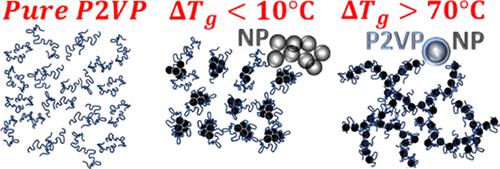促进缠结的钯纳米颗粒显著提高了聚2-乙烯基吡啶的玻璃化转变温度
IF 5.2
1区 化学
Q1 POLYMER SCIENCE
引用次数: 0
摘要
计算预测聚合物- np复合材料(PNC)的聚合物基体和纳米颗粒(NPs)之间的良好相互作用可以提高PNC的玻璃化转变温度(Tg),从而提高其热稳定性。然而,大多数pnc无法预测,很少出现Tg升高(10°C)的情况。这种Tg不变性被认为是由于在NP表面形成了一个结合的聚合物层。在这里,我们观察到相对于整齐的聚合物,由纠缠的聚(2-乙烯基吡啶)(P2VP)和~ 3nm Pd NPs制成的pnc的Tg显著升高,高达73.7℃,即使x射线散射显示NP表面存在结合的P2VP层。流变学和结构分析表明,前所未有的Tg升高源于NPs的纠缠促进作用,这反过来又由NPs的纳米尺寸和强基质- np相互作用实现。本文章由计算机程序翻译,如有差异,请以英文原文为准。

Drastic Elevation in the Glass Transition Temperature of Poly(2-vinylpyridine) by the Entanglement-Promoting Palladium Nanoparticles
A favorable interaction between the polymer matrix and nanoparticles (NPs) of a polymer-NP composite (PNC) is computationally predicted to raise a PNC’s glass transition temperature (Tg) and thus enhance its thermal stability. Yet, most PNCs fail the prediction and seldom exhibit >10 °C, if any, elevation in Tg; this Tg invariance is believed to result from the formation of a bound polymer layer on the NP surface. Here, we observe considerable Tg elevations, by as much as 73.7 °C relative to the neat polymer, for the PNCs made of entangled poly(2-vinylpyridine) (P2VP) and ∼3 nm Pd NPs, even though a bound P2VP layer is revealed by X-ray scattering to be present on the NP surface. A rheological and structural analysis suggests that the unprecedented Tg elevations stem from the entanglement-promoting effect of the NPs, which is in turn enabled by the NPs’ nanoscopic size and the strong matrix-NP interaction.
求助全文
通过发布文献求助,成功后即可免费获取论文全文。
去求助
来源期刊

Macromolecules
工程技术-高分子科学
CiteScore
9.30
自引率
16.40%
发文量
942
审稿时长
2 months
期刊介绍:
Macromolecules publishes original, fundamental, and impactful research on all aspects of polymer science. Topics of interest include synthesis (e.g., controlled polymerizations, polymerization catalysis, post polymerization modification, new monomer structures and polymer architectures, and polymerization mechanisms/kinetics analysis); phase behavior, thermodynamics, dynamic, and ordering/disordering phenomena (e.g., self-assembly, gelation, crystallization, solution/melt/solid-state characteristics); structure and properties (e.g., mechanical and rheological properties, surface/interfacial characteristics, electronic and transport properties); new state of the art characterization (e.g., spectroscopy, scattering, microscopy, rheology), simulation (e.g., Monte Carlo, molecular dynamics, multi-scale/coarse-grained modeling), and theoretical methods. Renewable/sustainable polymers, polymer networks, responsive polymers, electro-, magneto- and opto-active macromolecules, inorganic polymers, charge-transporting polymers (ion-containing, semiconducting, and conducting), nanostructured polymers, and polymer composites are also of interest. Typical papers published in Macromolecules showcase important and innovative concepts, experimental methods/observations, and theoretical/computational approaches that demonstrate a fundamental advance in the understanding of polymers.
 求助内容:
求助内容: 应助结果提醒方式:
应助结果提醒方式:


